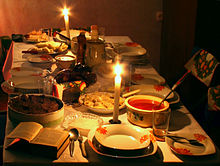Twelve-dish Christmas Eve supper


A twelve-dish Christmas Eve supper is traditionally prepared in Polish, Lithunian, and Ukrainian (The Polish-Lithuanian Commonwealth) cultures. The meal (Polish: Wigilia or Polish: wieczerza wigilijna, [Свята вечеря, Sviata vecheria] Error: {{Lang-xx}}: text has italic markup (help), Lithuanian: Kūčios) consists of twelve meatless dishes representing the twelve Apostles or twelve months of the year. The tradition of the supper can be traced back to pre-Christian times and connected with remembrance of the souls of deceased ancestors.
This was a common Eastern Orthodox tradition in the Russian Empire, which has become virtually extinct in Russia as a result of the official atheism of the former Soviet Union.[citation needed]
The supper consists of almost the same dishes in all three countries, though there are some variations between them. Because of the fast, no meat, eggs or milk are allowed during the supper. Thus fish, mushrooms and various types of grain are the main offerings.
In Poland and Ukraine the supper begins with eating kutia, but in Lithuania this tradition is rare. Instead, poppy milk (aguonų pienas) together with kūčiukai are served and forms a significant part of the Lithuanian Christmas Eve menu. Poppy seeds are widely used for Christmas Eve dishes, because they symbolize abundance and prosperity.
Regarding the fish dishes, usually herring, carp or pike are eaten. The fish symbolizes the ichthus, a fish-like symbol consisting of two intersecting arcs resembling the profile of a fish, used by early Christians as a secret symbol relating to Jesus and his disciples as "fishers of men." In Lithuania herring (Lithuanian: silkė) dishes are rich and variable. Usually silkė su morkomis (herring with carrots), or silkė su grybais (herring with mushrooms) are served on Christmas Eve.
Mushrooms, especially dried or pickled, are also one of the main dishes eaten on Christmas Eve. Sauerkraut with wild mushrooms or peas, red borscht, mushroom or fish soups are eaten in Poland and Ukraine.
Boiled or deep fried pierogis (dumplings) (Polish: pierogi, Ukrainian: вареники, varenyky, Lithuanian:auselės) with a wide variety of fillings (sauerkraut, mushrooms, smashed poppy seeds, etc.), are among the most popular dishes. Doughnuts filled with jam (Polish:pączki, Ukrainian: пампушки, pampushky) are served for a dessert in Poland and Ukraine, but in Lithuania sweet dishes are not common, as they are believed inappropriate for the atmosphere of the evening.

As for beverages, traditionally dried fruit compote or cranberry kisiel (Lithuanian: spanguolių kisielius) are common[citation needed]. In the earlier times oaten kisiel was more common.
The Christmas Eve supper is usually held under candle light and starts in the evening after the first star appears in the sky. The star symbolizes the birth of Jesus in Christian tradition and a soul of deceased ancestors in pre-Christian beliefs. Quiet, dim-lighting, and a somewhat mystical atmosphere is characteristic for Christmas Eve supper[citation needed]. It is said in Lithuania that many strange things happen on that night and there are plenty of rituals and magic associated with Christmas Eve. See also Christmas Eve Magic. In Poland, western Ukraine, and Bukovyna, an extra plate and seat are always left for anyone, such as a drifter, to be accepted as a guest. It is believed that he may be Jesus and should be welcomed.
